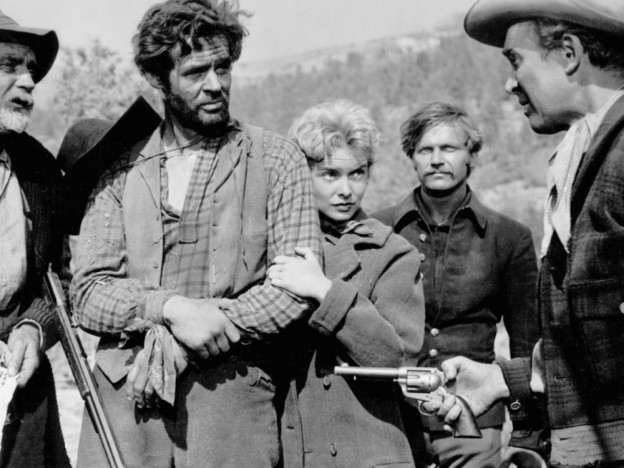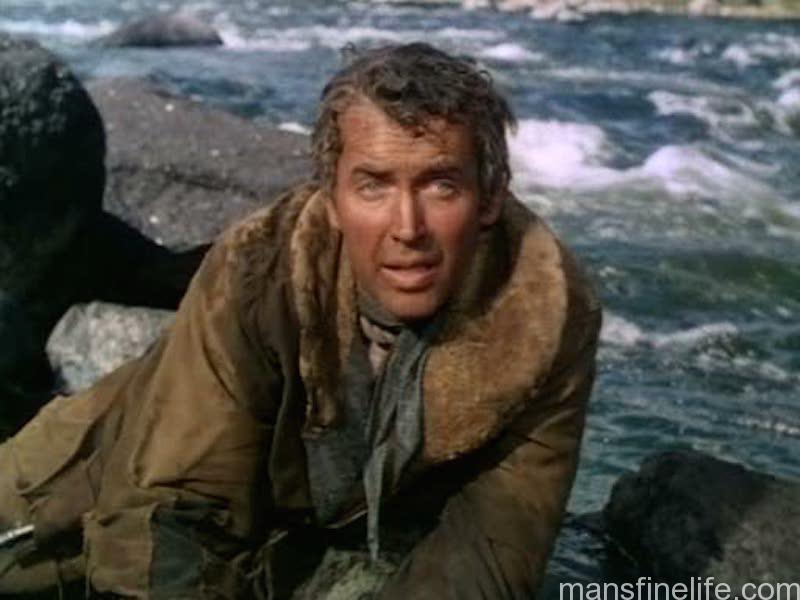The third Western in a sequence of five innovative collaborations between director Anthony Mann and Hollywood legend James Stewart, 1953s The Naked Spur is arguably the leanest of them all if not quite the meanest (that honor goes to the slightly later and still shocking The Man From Laramie). With an excellent supporting cast of only four other players, Spur’s taught plot unwinds in the period directly after the Civil War and finds former Union soldier and rancher-turned-bounty hunter Howard Kemp (Stewart) looking to capture fugitive murderer Ben Vandergroat (a constantly laughing and manipulative Robert Ryan, one of the screen’s great neurotic villains) in order to claim the reward on his head and then buy back his lost ranch. Kemp is helped in his tawdry task first by no-luck prospector Jesse Tate (the always excellent character actor Millard Mitchell) and then a dishonorably discharged soldier-adventurer Roy Anderson (the underrated and wonderfully cynical Ralph Meeker), whose morals are definitely flexible. When the hastily assembled trio corner and capture Vandergroat, they discover he is traveling with the young daughter of one his slain gang, Lina Patch (a very lovely and pixieish Janet Leigh). Tate and Anderson also find out, courtesy of the always-plotting Vandergroat, that Kemp is no lawman and also that the reward on him is a staggering $5000. Confronted with this uncomfortable fact, Kemp reluctantly agrees to deal his other two “partners” in for equal shares of the reward. But shortly after the group heads out for Abilene to turn Vandergroat in, Kemp is shot in a needless confrontation with Blackfoot Indians pursuing the unreliable Anderson, leaving him wounded and ever more at the mercy of his dubious companions and the ever-scheming Vandergroat. With the reward payable dead or alive, and Vandergroat set to hang for his murder, the tension ratchets up as the three “good guys” debate whether they should even bother to keep the fugitive alive, Kemp and Lina begin to fall in love and Vandergroat shrewdly tries to manipulate the others so they will turn on each other and he can make his escape.
https://www.youtube.com/watch?v=4nrXxIDK0Dc
The seminal films with Stewart marked a turning point in Mann’s career, his middle period really, as he graduated from very good black & white crime thrillers on tight RKO budgets to expansive location Westerns eventually shot in Technicolor. In his last period, Mann would move on to massive widescreen historical epics such as the remarkable El Cid and the sweeping The Fall of the Roman Empire. But Mann first brought his hard boiled noir sensibilities to the Western and as a result his heroes are much more flawed than John Ford’s prairie Galahads and Howard Hawks’ tough talkers with hearts of gold. The cinematography in Mann’s Westerns is also distinctive, with almost total location shooting but a less glossy sense of composition than Ford’s beautiful Monument Valley vistas, a less prettified vision of the untamed wilderness and one that is at times claustraphobic rather than expansive. This results in the integration of the terrain as a subliminal player in the story and emphasizes the characters’ intimate and often precarious connection to the physical world instead of simply serving as a beautiful backdrop to be ridden through on horseback.
It has been said countless times by amateur cinema psychiatrists that his World War II service as a bomber pilot changed Stewart, hardening his previously soft edges and adding a pronounced flintiness to leaven his innate amiability. But if that is true of Stewart it is also true of America as a whole in the post-war era. It was Mann’s genius to take the heroic Code of the West and in the 1950s mold it into something new and distinct, a reflection of the hard-earned knowledge that life is not black and white and that violence is neither clean, neat or pretty. With Stewart’s intensely emotional, at times near-hysterical portrayals of essentially good men struggling with their own besieged sense of honor in a morally compromised world where sudden violence could change a life forever, he created a new kind of hero, at once tough and vulnerable, true to a code but unable to define exactly the boundaries of that code as it came right up to the edge of, and sometimes crossed, the bright line between right and wrong. And with these 1950s Westerns, Mann brought a modern, unsentimental perspective to the genre, where the baddies are bad but not so bad that you don’t empathize a little with them and the good guys are riding out on a trail suffused with shades of gray. With Stewart’s standout performance as Kemp in The Naked Spur, and Mann’s unsentimental and deceptively complex treatment of the Western in this and their five other Western collaborations, these two great artists inspired a movement in the genre that seeded the ground for the next wave in the 1960s, the direct antecedent to Sam Peckinpaugh’s ultra-violent, ultra cynical The Wild Bunch and Sergio Leone’s self-aware, ultra-stylized “Spaghetti” Westerns. In doing so Stewart and Mann really inaugurated the last great period of American Westerns. So a film like The Naked Spur deserves to be watched not only for its own immediate pleasures and unimpeachable merits but as a part of a bigger oeuvre and the spur of a subtle but revolutionary artistic evolution in the medium.



